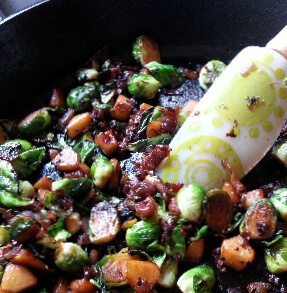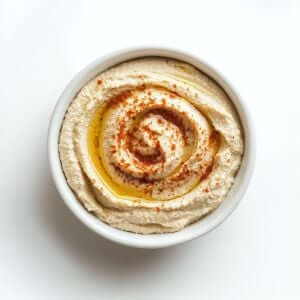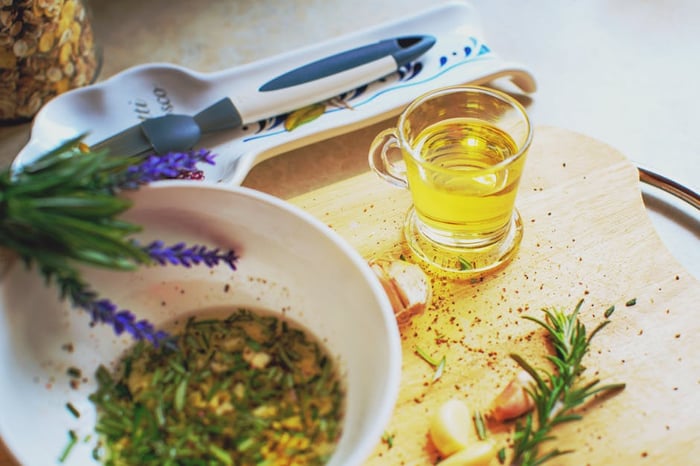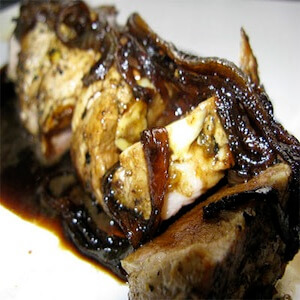Our Blog
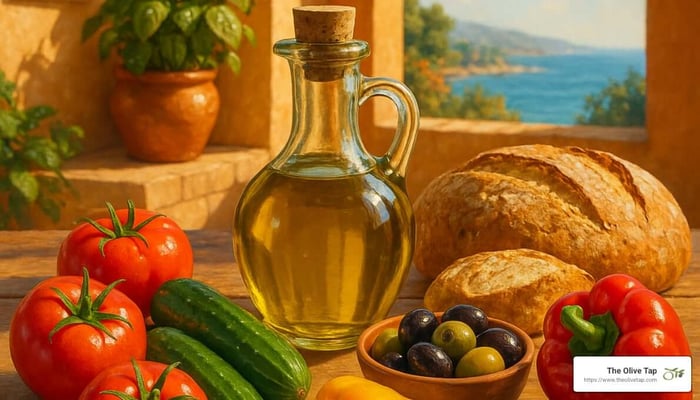
Mediterranean Olive Oil Recipes You'll Love
The Mediterranean Gold Standard: Cooking with Olive Oil
There's something magical about a sun-drenched Mediterranean table, where a bottle of golden olive oil takes center stage. Mediterranean cooking with olive oil isn't just a culinary technique—it's a celebration of flavor, health, and centuries-old tradition that transforms even the simplest ingredients into something extraordinary.
At the heart of this tradition lies extra virgin olive oil (EVOO), the highest quality and most nutritious type available. When you drizzle that vibrant green-gold liquid over a dish, you're not just adding flavor—you're connecting with one of the world's oldest and most beneficial culinary customs.
What makes Mediterranean olive oil so special? It starts with the cold-pressed production method that preserves all those natural antioxidants and complex flavors you simply won't find in refined oils. The result is an ingredient bursting with polyphenols (powerful plant compounds) and heart-healthy monounsaturated fats that have been linked to lower rates of cardiovascular disease and certain cancers.
Don't worry about cooking with your premium oil, either. With a smoke point ranging from 325°F to 400°F, quality EVOO handles most cooking methods beautifully—from gentle sautés to roasting and even some frying. In fact, traditional Mediterranean cooks don't reserve their good oil just for finishing dishes—they cook with it generously.
"If vegetables are the stars of Mediterranean cuisine, olive oil is the director," as one Greek grandmother states. This philosophy shines in classic "ladera" dishes (meaning "in oil")—vegetable-based main courses where olive oil isn't just a cooking medium but an essential part of the sauce and flavor profile.
Think of olive oil as a flavor improver that brings out the best in other ingredients. A herbal Tuscan Olive Oil might transform simple grilled bread into bruschetta, while a buttery Spanish EVOO variety might be the perfect partner for delicate seafood. Each region's oil carries its own personality, much like wine, reflecting the terroir and olive varieties of its origin.
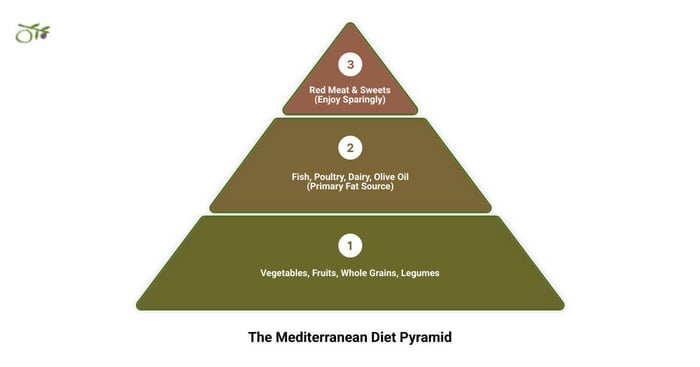
As you can see in this Mediterranean diet pyramid, olive oil forms the foundation of healthy eating patterns across Greece, Italy, Spain and beyond. It's not an occasional indulgence but a daily staple that brings vegetables, legumes, and whole grains to life.
Whether you're sautéing garlic for pasta, roasting a pan of colorful vegetables, finishing a soup with a swirl of green gold, or even baking a moist olive oil cake, Mediterranean cooking with olive oil adds depth and character while delivering remarkable health benefits. It truly is the Mediterranean gold standard—and the secret to changing everyday ingredients into extraordinary meals.
Mediterranean Cooking with Olive Oil: 10 Recipes You'll Love
There's something magical about the way olive oil transforms simple ingredients into extraordinary meals. As the heart of Mediterranean cuisine, this liquid gold doesn't just add flavor—it connects us to centuries of culinary tradition that's as healthy as it is delicious.
These ten recipes showcase the versatility of Mediterranean cooking with olive oil, from traditional Greek vegetable dishes to Italian pasta classics and even sweet treats that might surprise you. Each recipe highlights a different varietal or type of extra virgin olive oil, proving it's far more than just a cooking fat.
At The Olive Tap, we believe that cooking with premium olive oil isn't just about taste—it's about embracing a lifestyle that has sustained Mediterranean cultures for generations. These recipes will help you bring that sun-drenched tradition into your own kitchen, one delicious drizzle at a time.
For more inspiration, explore our full collection of Recipes Featuring Olive Oil and of course, many recipes with Olive Oil also feature quality Balsmic Vinegar.
1. Briam Greek Roasted "In Oil"
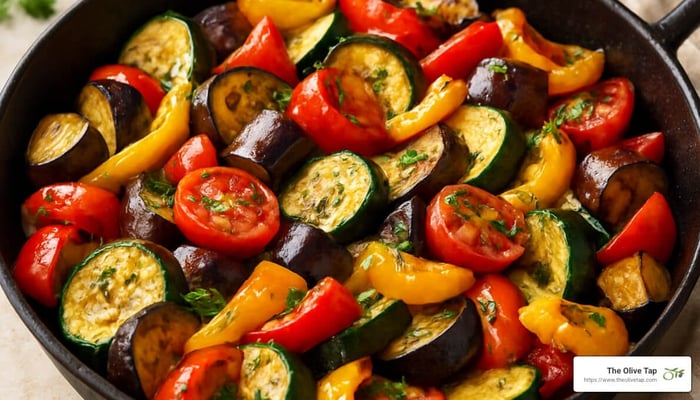
Briam perfectly exemplifies the Greek "ladera" tradition—vegetables cooked generously in olive oil until they surrender into tender, flavor-infused glory. This rustic dish transforms humble garden vegetables into something truly memorable.
Ingredients:
- 2 medium zucchini, sliced into rounds
- 1 large eggplant, cubed
- 2 red bell peppers, chunked
- 1 large red onion, sliced
- 4 ripe tomatoes, diced
- 4 garlic cloves, minced
- ½ cup The Olive Tap's Spanish Gold Extra Virgin Olive Oil or similar Varietal
- 2 tablespoons dried Greek oregano
- 1 tablespoon fresh thyme leaves
- Sea salt and freshly ground black pepper
- ¼ cup fresh parsley, chopped
Directions:
- Preheat oven to 400°F (200°C).
- In a large baking dish, combine all vegetables, garlic, herbs, salt, and pepper.
- Pour the olive oil over everything and toss well to coat.
- Bake uncovered for 45-60 minutes, stirring occasionally, until vegetables are tender and slightly caramelized.
- Sprinkle with fresh parsley before serving.
Here's a little secret from Greek grandmothers everywhere: Briam actually tastes better at room temperature after sitting for a while. The flavors have time to meld and deepen, making this perfect for meal prep—make it on Sunday and enjoy it throughout your busy week.
2. Spaghetti Aglio e Olio & Olio Nuovo Garlic Pasta
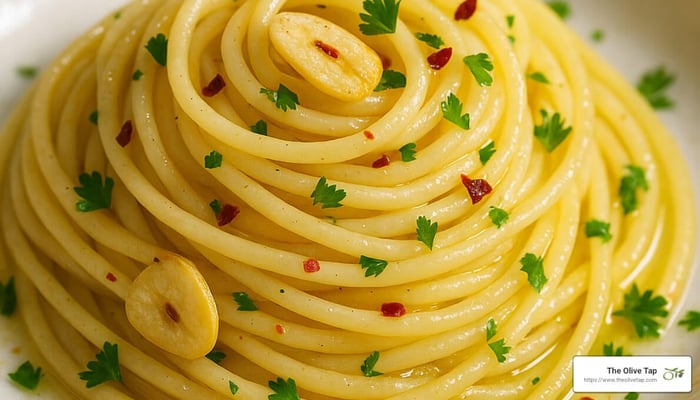
Sometimes the simplest dishes are the most revelatory. This classic Italian pasta requires just a handful of ingredients, with quality extra virgin olive oil taking center stage. It's the kind of meal that makes you wonder why you ever bothered with complicated sauces. A similar recipe, with a bit just a bit garlic is also on our website, Olio Nuovo Garlic Pasta.
Ingredients:
- 1 pound spaghetti or linguini
- ⅓ cup The Olive Tap's Italiano Extra Virgin Olive Oil or similar Varietal EVOO
- 6 large garlic cloves, thinly sliced
- ½ teaspoon red pepper flakes (adjust to taste)
- ¼ cup fresh parsley, chopped
- ½ cup reserved pasta water
- Salt to taste
- Freshly grated Parmesan cheese (optional)
Directions:
- Cook pasta in well-salted water until al dente. Reserve ½ cup pasta water before draining.
- While pasta cooks, gently heat olive oil in a large skillet over medium-low heat.
- Add sliced garlic and red pepper flakes, cooking until garlic is fragrant and just beginning to turn golden (about 2 minutes).
- Add drained pasta to the skillet along with a splash of the reserved pasta water.
- Toss continuously, adding more pasta water as needed to create a light sauce.
- Remove from heat, add parsley, and toss again.
- Serve immediately with optional Parmesan cheese.
The key to this dish is using high-quality olive oil—its flavor is the star. Our Italiano variety offers a balanced, medium-intensity profile that complements the garlic without overwhelming it. This is the kind of simple weeknight dinner that feels like a restaurant treat.
3. Ladolemono Greek Lemon–Olive Oil Vinaigrette
This bright, zesty dressing is a staple in Greek households, where it's drizzled over everything from crisp salads to grilled fish and roasted vegetables. The name "ladolemono" literally means "oil-lemon," highlighting the beautiful simplicity of its two star ingredients.
Ingredients:
- ½ cup The Olive Tap's Arbequina Extra Virgin Olive Oil
- ¼ cup freshly squeezed lemon juice
- 1 tablespoon Dijon mustard
- 2 garlic cloves, minced
- 1 teaspoon dried oregano
- ½ teaspoon salt
- ¼ teaspoon freshly ground black pepper
Directions:
- In a jar with a tight-fitting lid, combine all ingredients.
- Shake vigorously until emulsified and slightly thickened.
- Taste and adjust seasonings as needed.
- Store in the refrigerator for up to one week; bring to room temperature and shake well before using.
For the perfect emulsion that won't separate, add the olive oil last and very slowly while whisking continuously. The mustard helps stabilize everything, creating a creamy, cohesive dressing. The mild, fruity notes of Arbequina olive oil make it ideal here, allowing the lemon's brightness to shine through while adding body and richness. Check out even more Vinaigrette Recipes from our Recipe Library.
4. Olive Oil & Herb-Marinated Grilled Chicken
This versatile marinade doesn't just flavor chicken—it transforms it into a juicy, aromatic masterpiece worthy of any Mediterranean table. The olive oil works double-duty, carrying herb flavors deep into the meat while helping to create a beautiful caramelized exterior.
Ingredients:
- 2 pounds boneless, skinless chicken breasts or thighs
- ⅓ cup The Olive Tap's Tuscan Herb Infused Olive Oil
- 3 tablespoons fresh lemon juice
- 4 garlic cloves, minced
- 2 tablespoons fresh rosemary, chopped
- 2 tablespoons fresh thyme leaves
- 1 tablespoon dried oregano
- 1 teaspoon lemon zest
- 1 teaspoon salt
- ½ teaspoon black pepper
Directions:
- In a large bowl, whisk together all ingredients except chicken.
- Add chicken and turn to coat thoroughly.
- Cover and refrigerate for at least 2 hours, preferably overnight.
- Remove chicken from refrigerator 30 minutes before cooking.
- Preheat grill to medium-high heat.
- Grill chicken for 5-7 minutes per side (depending on thickness) until internal temperature reaches 165°F.
- Let rest for 5 minutes before slicing.
There's actual science behind why this marinade works so beautifully. The olive oil carries fat-soluble flavor compounds from herbs and spices deep into the meat, while the acid from lemon juice helps break down proteins, tenderizing the chicken. Meanwhile, the oil creates a protective barrier that locks in moisture during cooking. The result? Chicken that's juicy inside with wonderfully crisp edges.
See even more Chicken and Poultry Recipes. Apricot Balsamic Grilled Chicken is featured below.
5. Spanish Gazpacho with Early Harvest EVOO
This chilled Andalusian soup celebrates summer's best tomatoes, liftd with a generous drizzle of peppery olive oil that adds both flavor and silky texture. It's sunshine in a bowl—no cooking required.
Ingredients:
- 2 pounds ripe tomatoes, roughly chopped
- 1 cucumber, peeled and chopped
- 1 red bell pepper, seeded and chopped
- 1 small red onion, chopped
- 2 garlic cloves
- ¼ cup The Olive Tap's Coratina Extra Virgin Olive Oil, plus more for drizzling
- 2 tablespoons Sherry Vinegar
- 1 teaspoon salt
- ½ teaspoon cumin
- Pinch of cayenne pepper
- Fresh basil or parsley for garnish
Directions:
- Combine all ingredients except garnish in a blender.
- Blend until smooth, working in batches if necessary.
- Strain through a fine-mesh sieve for a smoother texture (optional).
- Refrigerate until thoroughly chilled, at least 2 hours.
- Serve in chilled bowls with an additional drizzle of olive oil and fresh herbs.
Our Coratina EVOO, harvested in Italy, offers grassy notes with a peppery finish that perfectly complements the sweet acidity of tomatoes. Its robust flavor stands up beautifully in this uncooked preparation, creating a vibrant soup that's as refreshing as it is satisfying.
6. Olive Oil Fried Brussels Sprouts with Sumac
This dish boldly challenges the myth that you can't use extra virgin olive oil for high-heat cooking. Thanks to its excellent oxidative stability, quality EVOO creates perfectly crispy Brussels sprouts with a depth of flavor other oils simply can't match.
Ingredients:
- 1 pound Brussels sprouts, rinsed, trimmed and halved (pat dry)
- ⅓ cup The Olive Tap's Extra Virgin Olive Oil
- 3 garlic cloves, thinly sliced
- 1 tablespoon sumac
- ½ teaspoon red pepper flakes
- Salt and freshly ground black pepper
- Lemon wedges for serving
Directions:
- Heat olive oil in a large skillet over medium-high heat until shimmering but not smoking.
- Add Brussels sprouts cut-side down in a single layer (work in batches if needed).
- Cook undisturbed for 3-4 minutes until deeply golden on the cut side.
- Add garlic and continue cooking, stirring occasionally, until sprouts are tender, about 3 more minutes.
- Remove from heat, sprinkle with sumac, red pepper flakes, salt, and pepper.
- Serve immediately with lemon wedges.
Tap's Tip: Use a splatter guard when cooking wetter ingredients like Brussels sprouts to prevent oil splatter. And remember, contrary to popular belief, a 2018 study found that extra virgin olive oil actually produces fewer harmful compounds when heated than oils with higher smoke points like corn oil. Science is finally catching up to what Mediterranean cooks have known for generations!
See another recipe, Glazed Brussel Sprouts with Apples and Prosciutto.
7. Creamy Hummus Drizzled with Arbequina EVOO
This silky smooth hummus celebrates olive oil twice—once in the preparation and again as a finishing touch that creates beautiful pools of liquid gold on top. It's a showstopper that will make store-bought versions pale in comparison.
Ingredients:
- 2 (15 oz) cans chickpeas, drained and rinsed
- ⅓ cup tahini
- ¼ cup The Olive Tap's Arbequina Extra Virgin Olive Oil, plus more for drizzling
- ¼ cup fresh lemon juice
- 2 garlic cloves
- ½ teaspoon ground cumin
- ½ teaspoon salt
- 2-4 tablespoons ice-cold water
- Paprika and chopped parsley for garnish
Directions:
- For ultra-smooth hummus, remove the skins from chickpeas by gently rubbing between paper towels (optional but recommended).
- In a food processor, combine chickpeas, tahini, olive oil, lemon juice, garlic, cumin, and salt.
- Process until smooth, scraping down sides as needed.
- With the processor running, slowly add ice water until you reach your desired consistency.
- Transfer to a serving bowl, create a well in the center with the back of a spoon.
- Fill the well with additional olive oil and sprinkle with paprika and parsley.
The mild, buttery character of Arbequina olive oil makes it perfect for hummus, complementing the earthy chickpeas without overwhelming them. As a finishing oil, it creates a beautiful contrast in both flavor and texture. Serve with warm pita and fresh vegetables for a mezze platter that will transport you straight to the Mediterranean.
See another recipe specifically for garlic lovers, Roasted Garlic Hummus.
8. Za'atar Eggs Fried in Olive Oil
Transform your breakfast routine with this Middle Eastern-inspired dish that proves olive oil belongs at the morning table too. The combination of crispy-edged eggs and aromatic za'atar creates a quick meal that feels special enough for weekend brunch but simple enough for weekday mornings.
Ingredients:
- 4 large eggs
- 3 tablespoons The Olive Tap's Extra Virgin Olive Oil
- 2 tablespoons za'atar spice blend
- Pinch of red pepper flakes (optional)
- Salt and freshly ground black pepper
- Fresh herbs (parsley, mint, or cilantro)
- Toasted pita bread for serving
Directions:
- Heat olive oil in a non-stick skillet over medium heat until shimmering.
- Crack eggs directly into the pan, being careful not to break the yolks.
- Sprinkle za'atar, salt, pepper, and red pepper flakes (if using) over the eggs.
- Cook until whites are set but yolks remain runny, about 2-3 minutes.
- Garnish with fresh herbs and serve immediately with toasted pita.
This simple dish showcases how olive oil can lift even the most basic ingredients. The fruity notes of the EVOO complement the aromatic za'atar, while creating beautifully crispy edges on the egg whites. It's a protein-packed start to the day with all the flavors of the Mediterranean.
Do you love garlic? Check out our Roasted Garlic Hummus Recipe too!
9. Orange Cardamom Olive Oil Cake
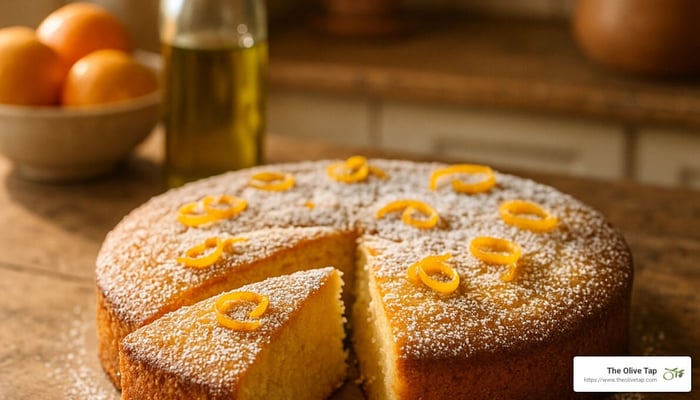
Baking with olive oil isn't just a healthy alternative to butter—it creates cakes with exceptional moisture and a unique flavor profile that butter simply can't match. This aromatic cake stays fresh for days (if it lasts that long!) and gets better as the flavors meld.
Ingredients:
- 2 cups all-purpose flour
- 1 teaspoon baking powder
- ½ teaspoon baking soda
- ½ teaspoon salt
- 1 teaspoon ground cardamom
- 3 large eggs
- 1½ cups granulated sugar
- 1 cup The Olive Tap's milder profile EVOO such as Ascolano or Arbequina Extra Virgin Olive Oil
- 1 tablespoon orange zest
- ¼ cup fresh orange juice
- ¼ cup whole milk
- Powdered sugar for dusting
Directions:
- Preheat oven to 350°F. Grease and flour a 9-inch round cake pan.
- In a medium bowl, whisk together flour, baking powder, baking soda, salt, and cardamom.
- In a large bowl, beat eggs and sugar until pale and fluffy, about 3 minutes.
- Slowly stream in olive oil while beating continuously.
- Add orange zest and juice, mixing until combined.
- Alternate adding flour mixture and milk, beginning and ending with flour, mixing just until incorporated.
- Pour batter into prepared pan and bake for 45-50 minutes, until a toothpick inserted comes out clean.
- Cool in pan for 20 minutes, then transfer to a wire rack to cool completely.
- Dust with powdered sugar before serving.
The fruity notes of the Ascolano or Arbequina Extra Virgin Olive Oil complement the citrus and cardamom beautifully, while creating a cake with an incredibly moist crumb. Serve with a dollop of Greek yogurt for a dessert that's indulgent yet somehow still feels virtuous.
10. Mediterranean Olive Oil Chocolate Chip Cookies
These cookies offer a Mediterranean twist on an American classic, proving that olive oil can work magic in all kinds of baking. The result? A cookie with crisp edges, chewy centers, and a complexity that butter-based versions can only dream of.
Ingredients:
- 2¼ cups all-purpose flour
- 1 teaspoon baking soda
- 1 teaspoon salt
- ¾ cup The Olive Tap's milder profile Ascolano or Arbequina Extra Virgin Olive Oil. For a nutty twist, French Roasted Walnut Oil would also be delish!
- ¾ cup packed brown sugar
- ½ cup granulated sugar
- 2 large eggs
- 2 teaspoons vanilla extract
- 2 cups semi-sweet chocolate chips
- Flaky sea salt for topping (optional)
Directions:
- Preheat oven to 350°F. Line baking sheets with parchment paper.
- In a medium bowl, whisk together flour, baking soda, and salt.
- In a large bowl, beat olive oil and both sugars until well combined.
- Add eggs one at a time, beating well after each addition, then mix in vanilla.
- Gradually add flour mixture, mixing just until incorporated.
- Fold in chocolate chips.
- Drop tablespoon-sized balls of dough onto prepared baking sheets, spacing 2 inches apart.
- Bake for 10-12 minutes, until edges are golden but centers are still soft.
- Sprinkle with flaky sea salt while still warm, if desired.
- Cool on baking sheets for 5 minutes, then transfer to wire racks.
The Olive Oil or Walnut Oil creates cookies with a tender interior and slightly crisp exterior that stays fresh longer than butter-based cookies. The mild Ascolano or Arbequina variety adds subtle fruity notes that complement the chocolate without overwhelming it. These kid-friendly, and adult-friendly, treats might just become your new go-to recipe.
See another recipe variation, Nicole's Chocolate Chip Cookies.
Choosing & Storing Your Liquid Gold
Finding the perfect olive oil is like finding a culinary treasure—it transforms everyday cooking into something truly special. At The Olive Tap, we love helping our customers understand what makes an exceptional olive oil and how to keep it at its best.
The journey to great Mediterranean cooking with olive oil begins with selecting the right bottle. When browsing olive oils, it's always good tocheck for the "extra virgin" designation first. This isn't just fancy marketing—it means the oil was extracted purely by mechanical means, without chemicals or excessive heat, and meets strict acidity standards of 0.8% or less. It's the highest quality olive oil you can buy, and you can truly taste the difference.
Fresh olive oil makes all the difference in your dishes. Unlike wine, olive oil doesn't get better with age—quite the opposite! Purchase olive oils from specialty retailers such as The Olive Tap where the Harvest or Press Date is clearly known. Otherwise, you can also look for bottles with a note on the Harvest or Press Date (ideally pressed within the past year). This ensures you're getting all those wonderful flavors and health benefits at their peak.
Have you ever noticed how quality olive oils come in dark glass bottles? There's science behind this choice. Light is olive oil's enemy, causing it to degrade faster. Those beautiful dark green or amber bottles aren't just for show—they're protecting your liquid gold from harmful light exposure.
You will find out that oils with specific origin information often deliver more distinctive flavors. Single-source oils from particular regions (like specific valleys in Greece or hills in Italy) typically indicate a producer who takes pride in their product's unique characteristics. Cold-pressed oils preserve more of those wonderful nutrients and flavor compounds that make olive oil so special.
For your Mediterranean cooking with olive oil trips, here's a simple guide to understanding the different grades of Olive Oils. If you are looking for health benefits from your Olive Oil, it is important to purchase only Extra Virgin Olive Oils*. The Olive Tap does not carry Virgin, Pure/Regular or Light Olive Oils.
| Grade | Acidity Level | Production Method | Best Uses | Flavor Profile |
|---|---|---|---|---|
| Extra Virgin* | ≤0.8% | Cold-pressed, no chemicals | All cooking, finishing, dressings | Robust, fruity, may be peppery |
| Virgin | ≤1.5% | Mechanical extraction | Cooking, marinades | Milder than EVOO, may have slight defects |
| Pure/Regular | Refined oil with some virgin oil added | Chemical processing with heat | High-heat cooking | Neutral, little olive flavor |
| Light | Highly refined | Chemical processing | High-heat cooking, baking where olive flavor isn't wanted | Very neutral, no distinctive taste |
In your kitchen, you may wish to keep a few different varieties on hand. A robust, peppery oil (such as Athenolia or Coratina) adds incredible finishing touches to soups and grilled vegetables. A medium-bodied oil (such as Kalamata) works beautifully for everyday cooking. And a mild, buttery oil (Arbequina is perfect) is an excellent go-to for baking and more delicate dishes for a very subtle olive flavor.
To learn even more on how to store your "Liquid Gold" and tips to avoid, read on.
Health Science Behind Mediterranean Cooking with Olive Oil
The health benefits of cooking with extra virgin olive oil aren't just folk wisdom—they're backed by solid science. What makes this ancient ingredient so remarkable from a nutritional standpoint?
The star players in olive oil are monounsaturated fatty acids (MUFAs), particularly oleic acid. These heart-healthy fats help reduce LDL (the "bad" cholesterol) while maintaining HDL (the "good" cholesterol) levels. It's a win-win for your cardiovascular system!
Extra virgin olive oil is also packed with polyphenols and antioxidants—up to 640 mg/kg in high-quality oils. These powerful compounds fight inflammation and oxidative stress in your body, potentially reducing your risk of various chronic diseases.
Despite what you might have heard, extra virgin olive oil is actually quite stable under heat. Its polyphenols and monounsaturated fats give it impressive heat stability. A fascinating 2018 study found that when heated, extra virgin olive oil produced fewer harmful compounds than oils with higher smoke points—quite contrary to popular belief!
When you cook with olive oil, most of its beneficial compounds stay intact. While some volatile flavor compounds might evaporate, the key nutrients like oleic acid, sterols, and polyphenols maintain their integrity throughout the cooking process.
The Mediterranean diet, which features olive oil as its primary fat, has been linked to reduced risk of heart disease, certain cancers, type 2 diabetes, and neurodegenerative diseases like Alzheimer's. A landmark study published in the New England Journal of Medicine found that participants following a Mediterranean diet supplemented with extra virgin olive oil had a 30% lower risk of major cardiovascular events compared to those on a low-fat diet. That's pretty remarkable for something that tastes so good!
Check out even more blog articles on the many Health Benefits of EVOO.
Common Myths About Mediterranean Cooking with Olive Oil
Despite olive oil's long history in Mediterranean cuisine, several persistent myths continue to circulate about cooking with this versatile ingredient.
Myth 1: You can't cook with extra virgin olive oil at high heat. Truth: This is perhaps the most common misconception heard! Extra virgin olive oil actually has a smoke point between 325°F and 400°F, making it perfectly suitable for most cooking methods including sautéing, roasting, and even frying. More importantly, its high oxidative stability means it produces fewer harmful compounds when heated than many oils with higher smoke points.
Myth 2: Heating olive oil destroys all its health benefits. Truth: While some volatile compounds may evaporate during cooking, the majority of olive oil's beneficial components—including its monounsaturated fats and many polyphenols—remain stable under heat. A study published in Food Chemistry found that even after 36 hours of continuous heating, olive oil retained most of its beneficial properties. Your quick stir-fry or 30-minute roast isn't going to destroy the goodness!
Myth 3: Light olive oil is healthier because it has fewer calories. Truth: All olive oils contain the same number of calories (about 120 per tablespoon). "Light" refers to the oil's color and flavor after refinement, not its caloric content. Extra virgin olive oil, though more robust in flavor, actually contains more beneficial compounds than refined "light" olive oil. Don't be fooled by marketing terms!
Myth 4: Olive oil goes rancid quickly when heated. Truth: Thanks to its antioxidant content and fat composition, extra virgin olive oil is actually one of the most stable cooking oils. Research shows it can withstand 24-27 hours of continuous frying before degrading, compared to just 15 hours for standard vegetable oil. Your dinner is safe!
Ready to explore our collection of premium olive oils to lift your Mediterranean cooking? Browse our selection of Extra Virgin Olive Oils and find the difference quality makes. Learn even more about Cooking with Olive Oil.
FAQs
Is extra virgin olive oil safe for high-heat sautéing?
Can I deep-fry with EVOO or should I switch oils?
Did you know, for a deep fried experience without all of the oil, Extra Virgin Olive Oil can be brushed on foods for use within Air Fryers too!
How long does an opened bottle stay fresh?
Conclusion
Embracing Mediterranean cooking with olive oil is more than just adding a new ingredient to your pantry—it's welcoming a centuries-old tradition that beautifully balances exceptional flavor with remarkable health benefits. From the rustic "ladera" vegetables of Greece to the silky olive oil cakes of Italy, this liquid gold transforms everyday ingredients into meals that nourish both body and soul.
At The Olive Tap, we're genuinely passionate about bringing the Mediterranean's finest olive oils to your kitchen. There's something magical about watching a good olive oil glisten as it's drizzled over a summer tomato salad or hearing that satisfying sizzle when vegetables hit a hot pan coated with premium EVOO. These small moments connect us to a culinary tradition that spans thousands of years.
Quality really does matter when it comes to olive oil. The difference between a mass-produced bottle and a carefully crafted extra virgin olive oil is like night and day—in flavor, health benefits, and cooking performance. When you choose cold-pressed oils in protective dark glass bottles, check or ask about the harvest dates, and explore different regional varieties, you're setting yourself up for Mediterranean cooking success.
You will find that there's something deeply satisfying about finishing a dish with a generous drizzle of robust olive oil—watching it create pools of liquid gold on creamy hummus or bring a final touch of brightness to a bowl of soup. As the old Greek saying goes, "Add olive oil and have courage"—sound advice for both cooking and life!
We invite you to explore The Olive Tap's collection of premium olive oils from award-winning producers around the Mediterranean. Whether you're just beginning your olive oil journey or you're looking to expand your collection with some specialty varieties, we're here to help you find the perfect oils for your kitchen.
Your taste buds—and your health—will thank you for bringing a little Mediterranean sunshine to your table, one delicious drop at a time.


